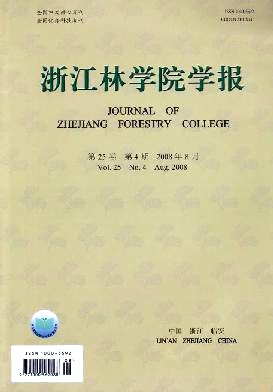| [1] |
PAN Chenhao, TANG Weiping, HUANG Han, HU Hanwen, YE Jin, CHEN Shenglong, WU Jiasen.
Niche and interspecific association of dominant species of woody plants in evergreen broad-leaved forest in Bailushan scenic area, Zhejiang Province
. Journal of Zhejiang A&F University,
2025, 42(3): 533-543.
doi: 10.11833/j.issn.2095-0756.20240458
|
| [2] |
CHEN Shiyan, CHENG Honghao, WU Xiaomeng, XU Yue, ZOU Yunding, BI Shoudong.
Interspecific competition of wandering spiders feeding on Empoasca onukii in tea plantations based on Fuzzy analysis
. Journal of Zhejiang A&F University,
2023, 40(5): 1008-1017.
doi: 10.11833/j.issn.2095-0756.20220753
|
| [3] |
DOU Xiaowen, WU Dengyu, ZHANG Xiaojing, TANG Mengping.
Study on the factors affecting breast-height basal area increment of evergreen broad-leaved forest in Mount Tianmu
. Journal of Zhejiang A&F University,
2023, 40(5): 1063-1072.
doi: 10.11833/j.issn.2095-0756.20220651
|
| [4] |
LI Chao, PEI Shunxiang, ZHANG Lianjin, GUO Jia, XIN Xuebing.
Applicability evaluation of competition indexes for Pinus tabuliformis plantations in Beijing
. Journal of Zhejiang A&F University,
2019, 36(6): 1115-1124.
doi: 10.11833/j.issn.2095-0756.2019.06.008
|
| [5] |
TANG Sijia, TANG Mengping, ZHAO Saisai, DU Xiufang, SHEN Qianyong, PANG Chunmei.
Competitive spatial patterns for Moso bamboo on Mount Tianmu
. Journal of Zhejiang A&F University,
2018, 35(2): 199-208.
doi: 10.11833/j.issn.2095-0756.2018.02.002
|
| [6] |
CHAO Lin, HONG Tao, LI Jian, CHEN Can, HONG Wei, WU Chengzhen.
Intraspecific competition in a Cunninghamia lanceolata plantation with different age and diameter classes
. Journal of Zhejiang A&F University,
2015, 32(3): 353-360.
doi: 10.11833/j.issn.2095-0756.2015.03.004
|
| [7] |
XU Jian, WEI Xinliang, WANG Jing, WANG Xianting, YU Lipeng.
Intraspecific and interspecific competition of dominant species in a deciduous, broadleaf forest of Longwang Mountain
. Journal of Zhejiang A&F University,
2014, 31(6): 868-876.
doi: 10.11833/j.issn.2095-0756.2014.06.007
|
| [8] |
FANG Guojing, TANG Mengping.
Spatial continuity for DBH in dominant populations of an evergreen broadleaved forest in National Nature Reserve of Mount Tianmu, China
. Journal of Zhejiang A&F University,
2014, 31(5): 663-667.
doi: 10.11833/j.issn.2095-0756.2014.05.001
|
| [9] |
CHEN Xiaorong, CHEN Yuanyuan, LUO Zhengrong, DING Bingyang.
A 5-year mid-mountain subtropical evergreen broadleaved forest study in Baishanzu,east China
. Journal of Zhejiang A&F University,
2013, 30(6): 821-829.
doi: 10.11833/j.issn.2095-0756.2013.06.004
|
| [10] |
SHANG Kankan.
Interspecific relationship of dominant populations in relict deciduous forests on Mount Tianmu, Eastern China
. Journal of Zhejiang A&F University,
2013, 30(2): 206-214.
doi: 10.11833/j.issn.2095-0756.2013.02.008
|
| [11] |
LUO Wen-jian, WEI Xin-liang, TANG Meng-ping, ZHANG Zhi-hua, WANG Jing, FENG Xue.
Intraspecific and interspecific competition in Liquidambar formosana on Mount Tianmu
. Journal of Zhejiang A&F University,
2012, 29(5): 641-646.
doi: 10.11833/j.issn.2095-0756.2012.05.001
|
| [12] |
YANG Guo-ping, GONG He-de, ZHENG Zheng, ZHANG Yi-ping, LIU Yu-hong, LU Zhi-yun.
Caloric values and ash content of six dominant tree species in an evergreen broadleaf forest of Ailaoshan,Yunnan Province
. Journal of Zhejiang A&F University,
2010, 27(2): 251-258.
doi: 10.11833/j.issn.2095-0756.2010.02.015
|
| [13] |
JIAN Min-fei, LIU Qi-jing, LIANG Yue-long, TANG Pei-rong.
Species number and structural characteristics of the subtropical,evergreen broad-leaved forest on Mount Jiulianshan,Jiangxi,China
. Journal of Zhejiang A&F University,
2008, 25(4): 458-463.
|
| [14] |
GONG He-de, ZHANG Yi-ping, LIU Yu-hong, YANG Guo-ping, LU Zhi-yun, LU Hua-zheng.
nterception capability in an evergreen broad-leaved forest of Ailaoshan,Yunnan Province
. Journal of Zhejiang A&F University,
2008, 25(4): 469-474.
|
| [15] |
AI Jian-guo, WENG Guo-hang, DONG Wei.
Interspecific association of primary plant populations in an evergreen broadleaf forest at Shiyang Forest Park of Zhejiang Province
. Journal of Zhejiang A&F University,
2008, 25(3): 324-330.
|
| [16] |
FANG Guo-jing, TANG Meng-ping, ZHANG Xue-lian.
The mingling index with evergreen broadleaf forests on Mount Tianmu
. Journal of Zhejiang A&F University,
2008, 25(2): 216-220.
|
| [17] |
XIE Chun-ping, YI Xian-gui, WANG Xian-rong.
Interspecies competition among dominant populations of Cerasus subhirtella var. ascendens community in Mount Wuyi of Fujian
. Journal of Zhejiang A&F University,
2008, 25(6): 718-722.
|
| [18] |
CAO Yong-hui, XIAO Jiang-hua, CHEN Shuang-lin, WU Bo-lin, WU Ming, ZHANG De-ming.
Effect of everygreen brood-leaved trees on Phyllostachys pubescens growth and their competition in the mixed forest
. Journal of Zhejiang A&F University,
2006, 23(1): 35-40.
|
| [19] |
JIN Ze-xin, CAI Hui-hua.
Dynamic characteristics of the dominant populations in different succession stages of evergreen broad-leaved forest on Tiantai Mountain in Zhejiang Province
. Journal of Zhejiang A&F University,
2005, 22(3): 272-276.
|
| [20] |
JIN Ze-xin, ZHOU Rong-man.
Quantitative relation of the intraspecific and interspecific competition in Shima superba
. Journal of Zhejiang A&F University,
2003, 20(3): 259-263.
|









 DownLoad:
DownLoad: